Sustainability Project: Developing Workplace Policies and Procedures
VerifiedAdded on 2023/06/17
|15
|3055
|302
Project
AI Summary
This project outlines the development and implementation of workplace sustainability policies and procedures. It includes a knowledge test covering key concepts, followed by a project component that involves minimizing resource use, adhering to environmental legislations, engaging stakeholders, and revising sustainability policies. The project also details the responsibilities of managers in implementing sustainable initiatives, promoting the benefits of sustainability to staff, and identifying effective sustainable initiatives. Furthermore, the project presents revised water-saving strategies and other measures to enhance the organization's sustainability efforts, aiming for a more environmentally responsible workplace.
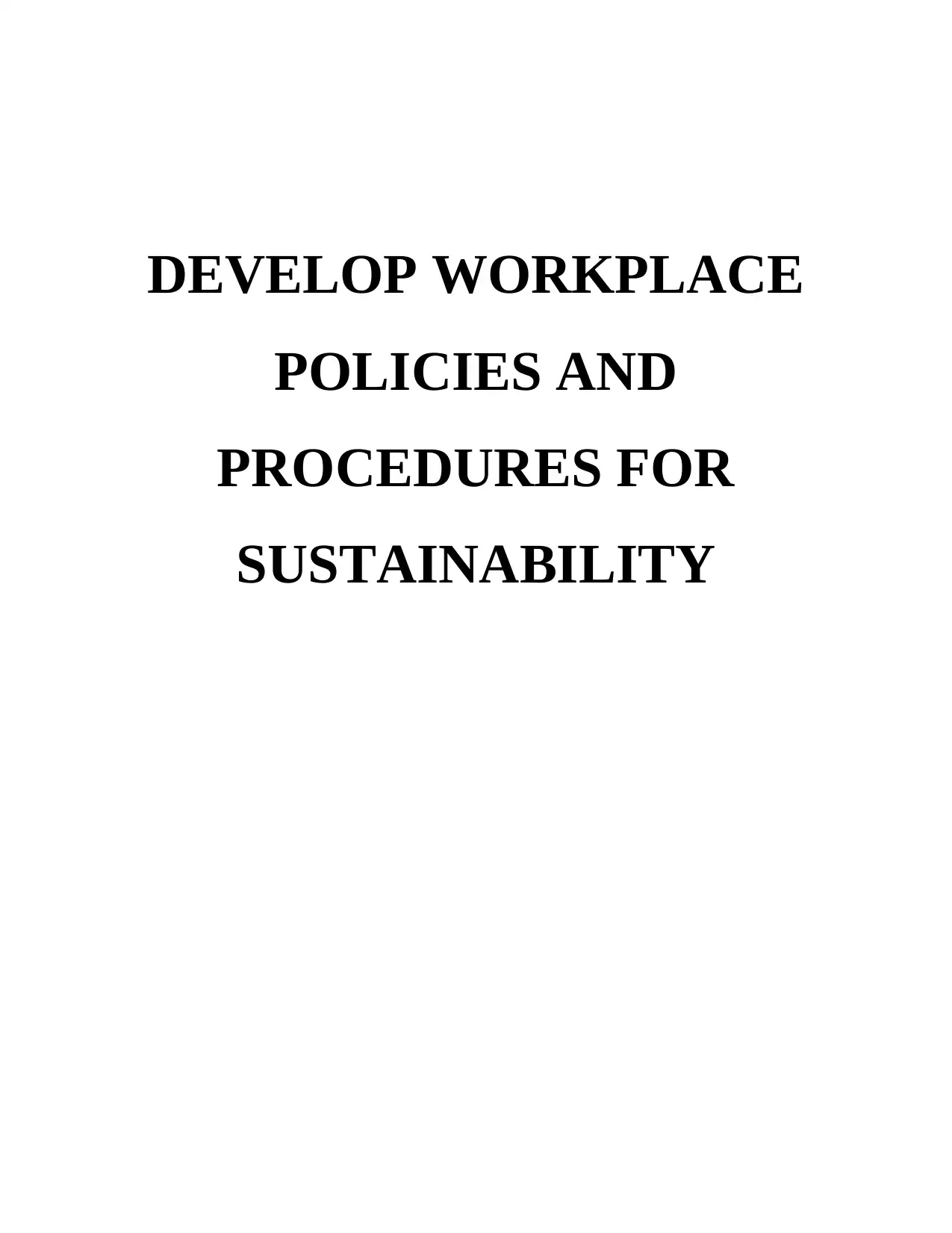
DEVELOP WORKPLACE
POLICIES AND
PROCEDURES FOR
SUSTAINABILITY
POLICIES AND
PROCEDURES FOR
SUSTAINABILITY
Paraphrase This Document
Need a fresh take? Get an instant paraphrase of this document with our AI Paraphraser
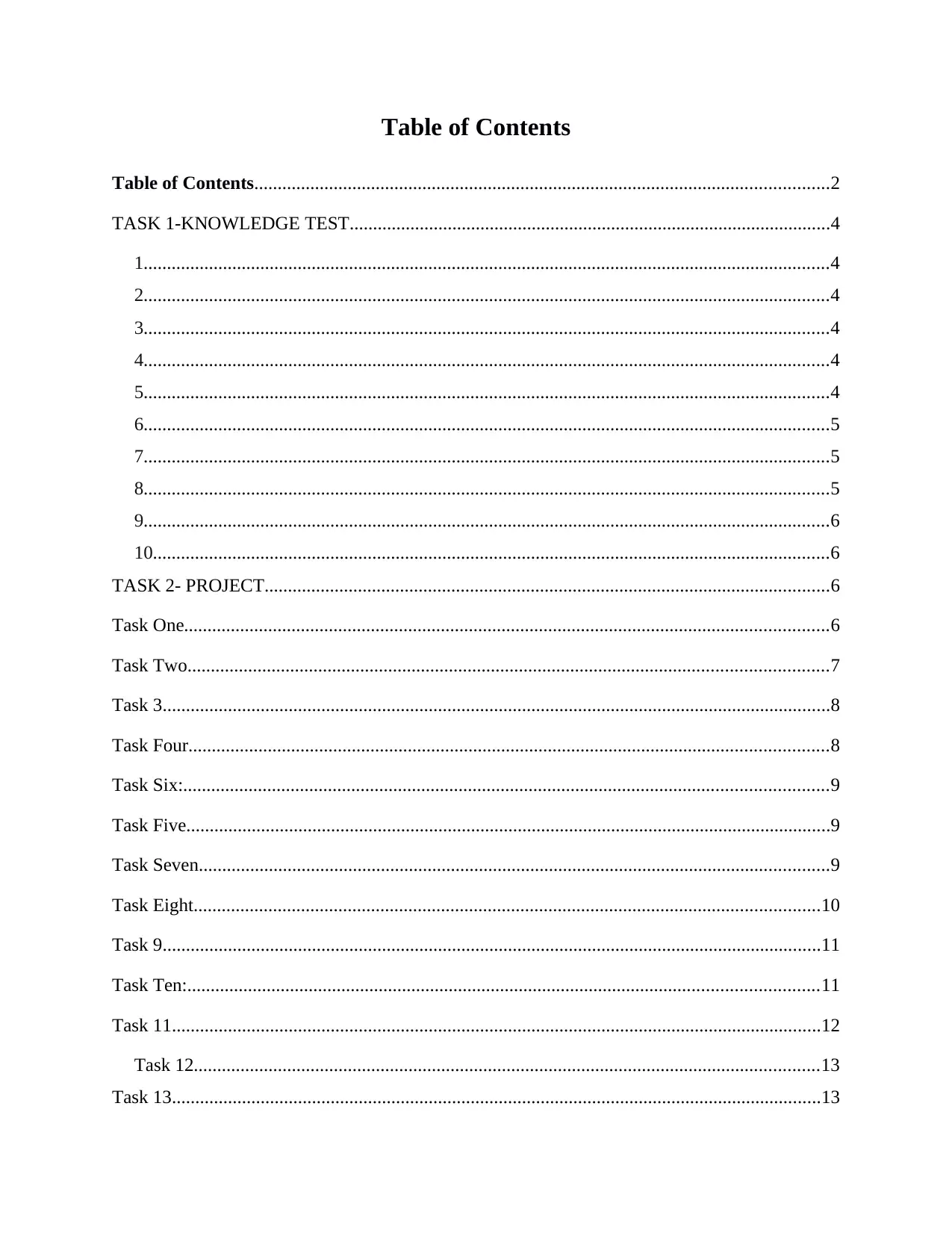
Table of Contents
Table of Contents...........................................................................................................................2
TASK 1-KNOWLEDGE TEST.......................................................................................................4
1...................................................................................................................................................4
2...................................................................................................................................................4
3...................................................................................................................................................4
4...................................................................................................................................................4
5...................................................................................................................................................4
6...................................................................................................................................................5
7...................................................................................................................................................5
8...................................................................................................................................................5
9...................................................................................................................................................6
10.................................................................................................................................................6
TASK 2- PROJECT.........................................................................................................................6
Task One..........................................................................................................................................6
Task Two.........................................................................................................................................7
Task 3...............................................................................................................................................8
Task Four.........................................................................................................................................8
Task Six:..........................................................................................................................................9
Task Five..........................................................................................................................................9
Task Seven.......................................................................................................................................9
Task Eight......................................................................................................................................10
Task 9.............................................................................................................................................11
Task Ten:.......................................................................................................................................11
Task 11...........................................................................................................................................12
Task 12......................................................................................................................................13
Task 13...........................................................................................................................................13
Table of Contents...........................................................................................................................2
TASK 1-KNOWLEDGE TEST.......................................................................................................4
1...................................................................................................................................................4
2...................................................................................................................................................4
3...................................................................................................................................................4
4...................................................................................................................................................4
5...................................................................................................................................................4
6...................................................................................................................................................5
7...................................................................................................................................................5
8...................................................................................................................................................5
9...................................................................................................................................................6
10.................................................................................................................................................6
TASK 2- PROJECT.........................................................................................................................6
Task One..........................................................................................................................................6
Task Two.........................................................................................................................................7
Task 3...............................................................................................................................................8
Task Four.........................................................................................................................................8
Task Six:..........................................................................................................................................9
Task Five..........................................................................................................................................9
Task Seven.......................................................................................................................................9
Task Eight......................................................................................................................................10
Task 9.............................................................................................................................................11
Task Ten:.......................................................................................................................................11
Task 11...........................................................................................................................................12
Task 12......................................................................................................................................13
Task 13...........................................................................................................................................13
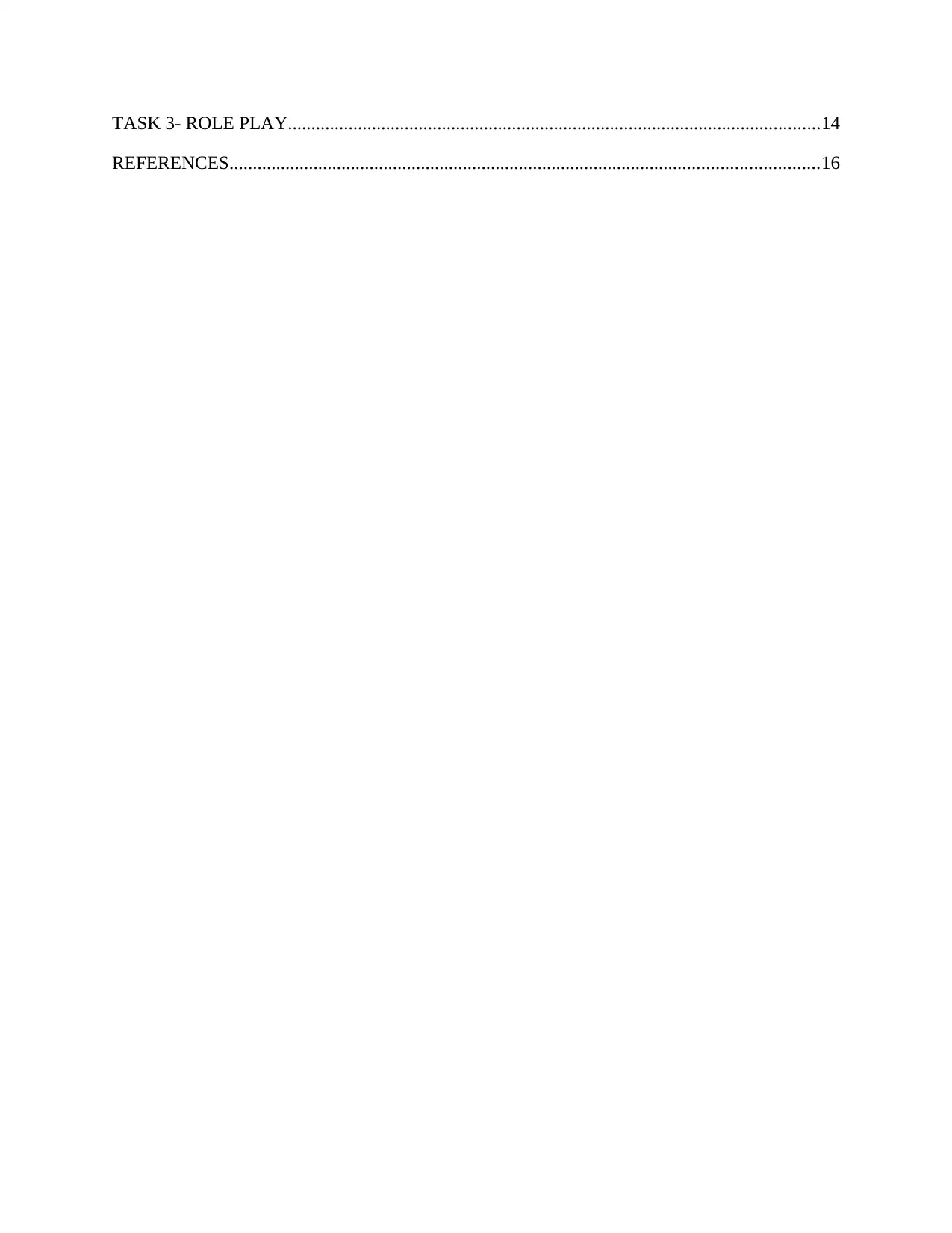
TASK 3- ROLE PLAY..................................................................................................................14
REFERENCES..............................................................................................................................16
REFERENCES..............................................................................................................................16
⊘ This is a preview!⊘
Do you want full access?
Subscribe today to unlock all pages.

Trusted by 1+ million students worldwide
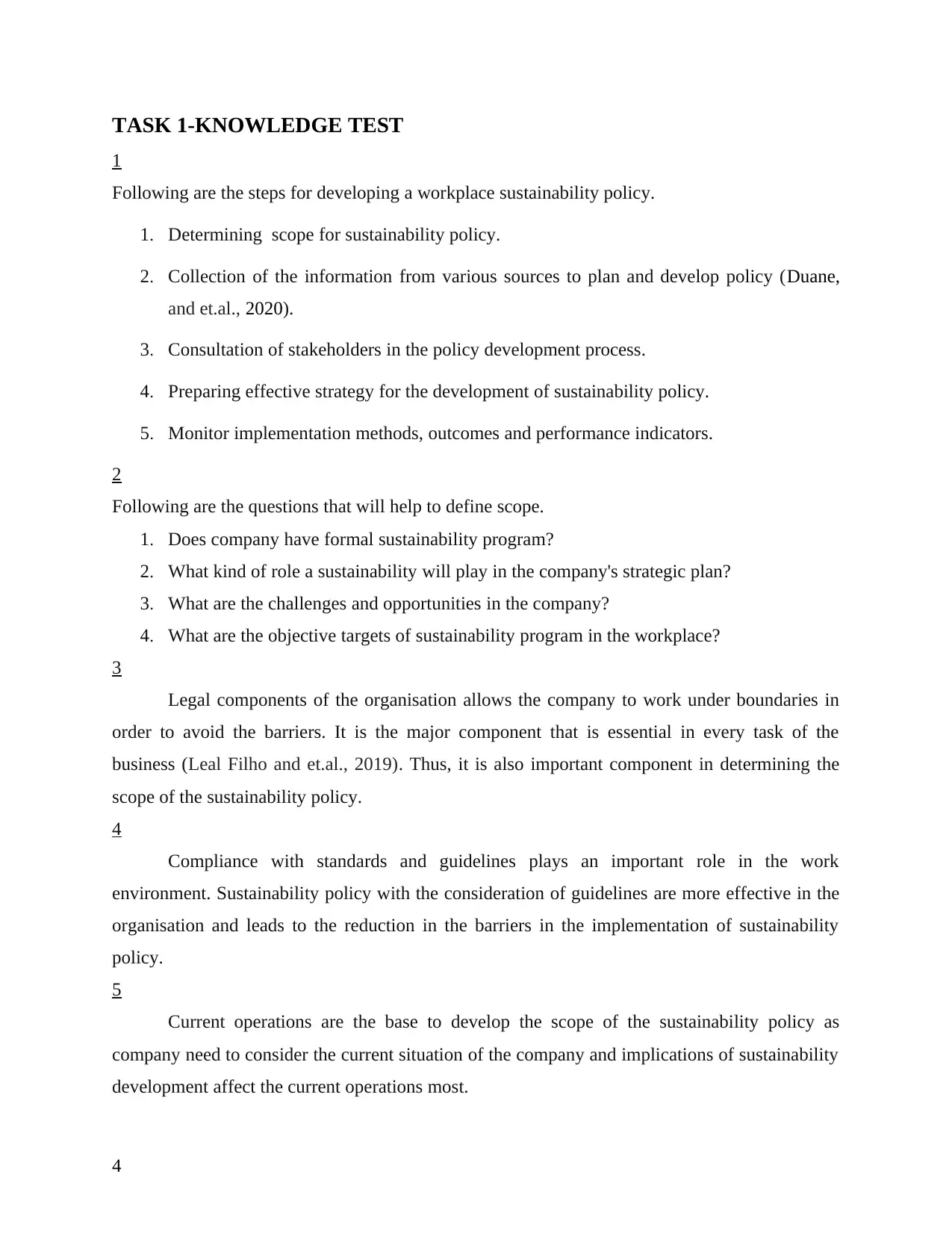
TASK 1-KNOWLEDGE TEST
1
Following are the steps for developing a workplace sustainability policy.
1. Determining scope for sustainability policy.
2. Collection of the information from various sources to plan and develop policy (Duane,
and et.al., 2020).
3. Consultation of stakeholders in the policy development process.
4. Preparing effective strategy for the development of sustainability policy.
5. Monitor implementation methods, outcomes and performance indicators.
2
Following are the questions that will help to define scope.
1. Does company have formal sustainability program?
2. What kind of role a sustainability will play in the company's strategic plan?
3. What are the challenges and opportunities in the company?
4. What are the objective targets of sustainability program in the workplace?
3
Legal components of the organisation allows the company to work under boundaries in
order to avoid the barriers. It is the major component that is essential in every task of the
business (Leal Filho and et.al., 2019). Thus, it is also important component in determining the
scope of the sustainability policy.
4
Compliance with standards and guidelines plays an important role in the work
environment. Sustainability policy with the consideration of guidelines are more effective in the
organisation and leads to the reduction in the barriers in the implementation of sustainability
policy.
5
Current operations are the base to develop the scope of the sustainability policy as
company need to consider the current situation of the company and implications of sustainability
development affect the current operations most.
4
1
Following are the steps for developing a workplace sustainability policy.
1. Determining scope for sustainability policy.
2. Collection of the information from various sources to plan and develop policy (Duane,
and et.al., 2020).
3. Consultation of stakeholders in the policy development process.
4. Preparing effective strategy for the development of sustainability policy.
5. Monitor implementation methods, outcomes and performance indicators.
2
Following are the questions that will help to define scope.
1. Does company have formal sustainability program?
2. What kind of role a sustainability will play in the company's strategic plan?
3. What are the challenges and opportunities in the company?
4. What are the objective targets of sustainability program in the workplace?
3
Legal components of the organisation allows the company to work under boundaries in
order to avoid the barriers. It is the major component that is essential in every task of the
business (Leal Filho and et.al., 2019). Thus, it is also important component in determining the
scope of the sustainability policy.
4
Compliance with standards and guidelines plays an important role in the work
environment. Sustainability policy with the consideration of guidelines are more effective in the
organisation and leads to the reduction in the barriers in the implementation of sustainability
policy.
5
Current operations are the base to develop the scope of the sustainability policy as
company need to consider the current situation of the company and implications of sustainability
development affect the current operations most.
4
Paraphrase This Document
Need a fresh take? Get an instant paraphrase of this document with our AI Paraphraser
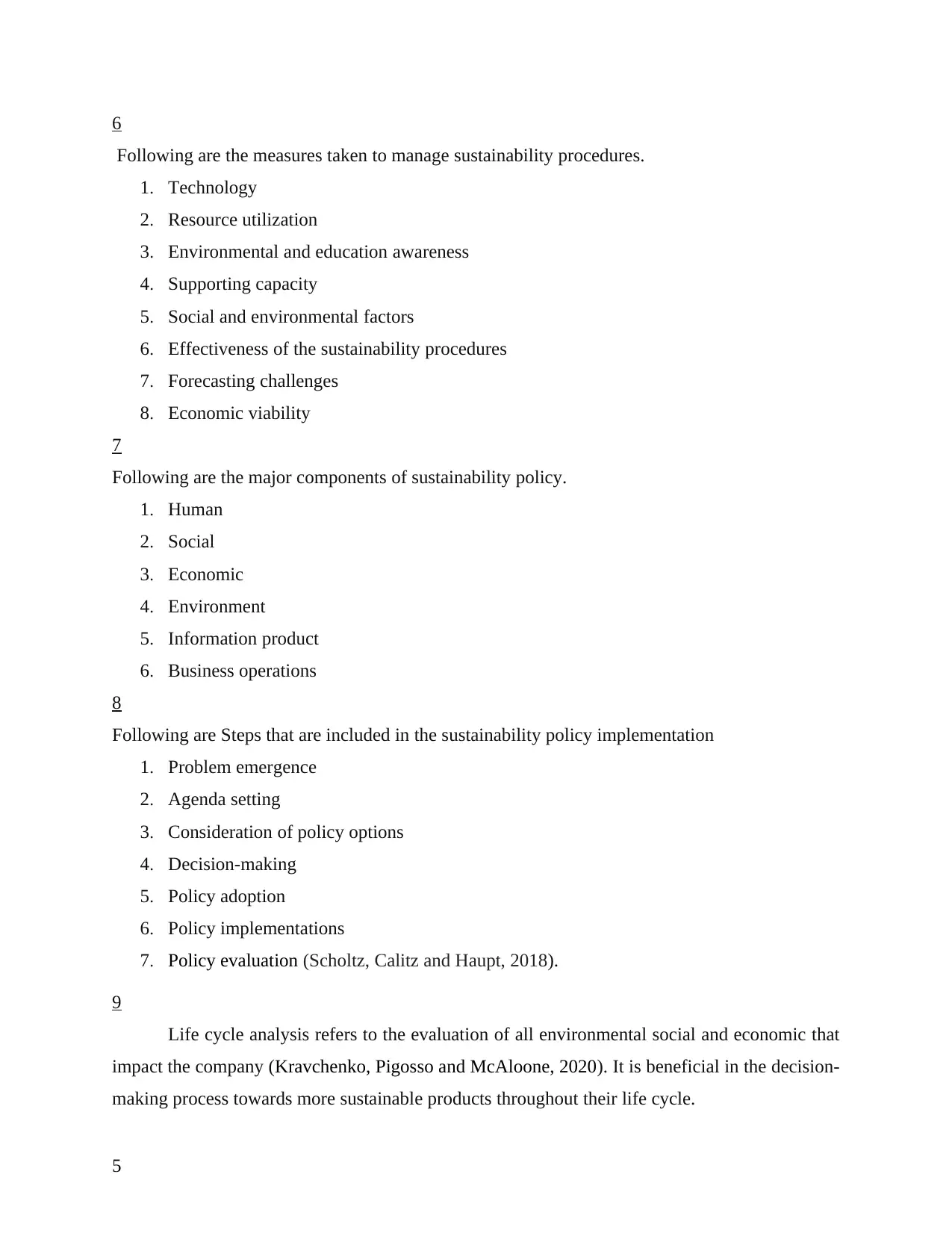
6
Following are the measures taken to manage sustainability procedures.
1. Technology
2. Resource utilization
3. Environmental and education awareness
4. Supporting capacity
5. Social and environmental factors
6. Effectiveness of the sustainability procedures
7. Forecasting challenges
8. Economic viability
7
Following are the major components of sustainability policy.
1. Human
2. Social
3. Economic
4. Environment
5. Information product
6. Business operations
8
Following are Steps that are included in the sustainability policy implementation
1. Problem emergence
2. Agenda setting
3. Consideration of policy options
4. Decision-making
5. Policy adoption
6. Policy implementations
7. Policy evaluation (Scholtz, Calitz and Haupt, 2018).
9
Life cycle analysis refers to the evaluation of all environmental social and economic that
impact the company (Kravchenko, Pigosso and McAloone, 2020). It is beneficial in the decision-
making process towards more sustainable products throughout their life cycle.
5
Following are the measures taken to manage sustainability procedures.
1. Technology
2. Resource utilization
3. Environmental and education awareness
4. Supporting capacity
5. Social and environmental factors
6. Effectiveness of the sustainability procedures
7. Forecasting challenges
8. Economic viability
7
Following are the major components of sustainability policy.
1. Human
2. Social
3. Economic
4. Environment
5. Information product
6. Business operations
8
Following are Steps that are included in the sustainability policy implementation
1. Problem emergence
2. Agenda setting
3. Consideration of policy options
4. Decision-making
5. Policy adoption
6. Policy implementations
7. Policy evaluation (Scholtz, Calitz and Haupt, 2018).
9
Life cycle analysis refers to the evaluation of all environmental social and economic that
impact the company (Kravchenko, Pigosso and McAloone, 2020). It is beneficial in the decision-
making process towards more sustainable products throughout their life cycle.
5
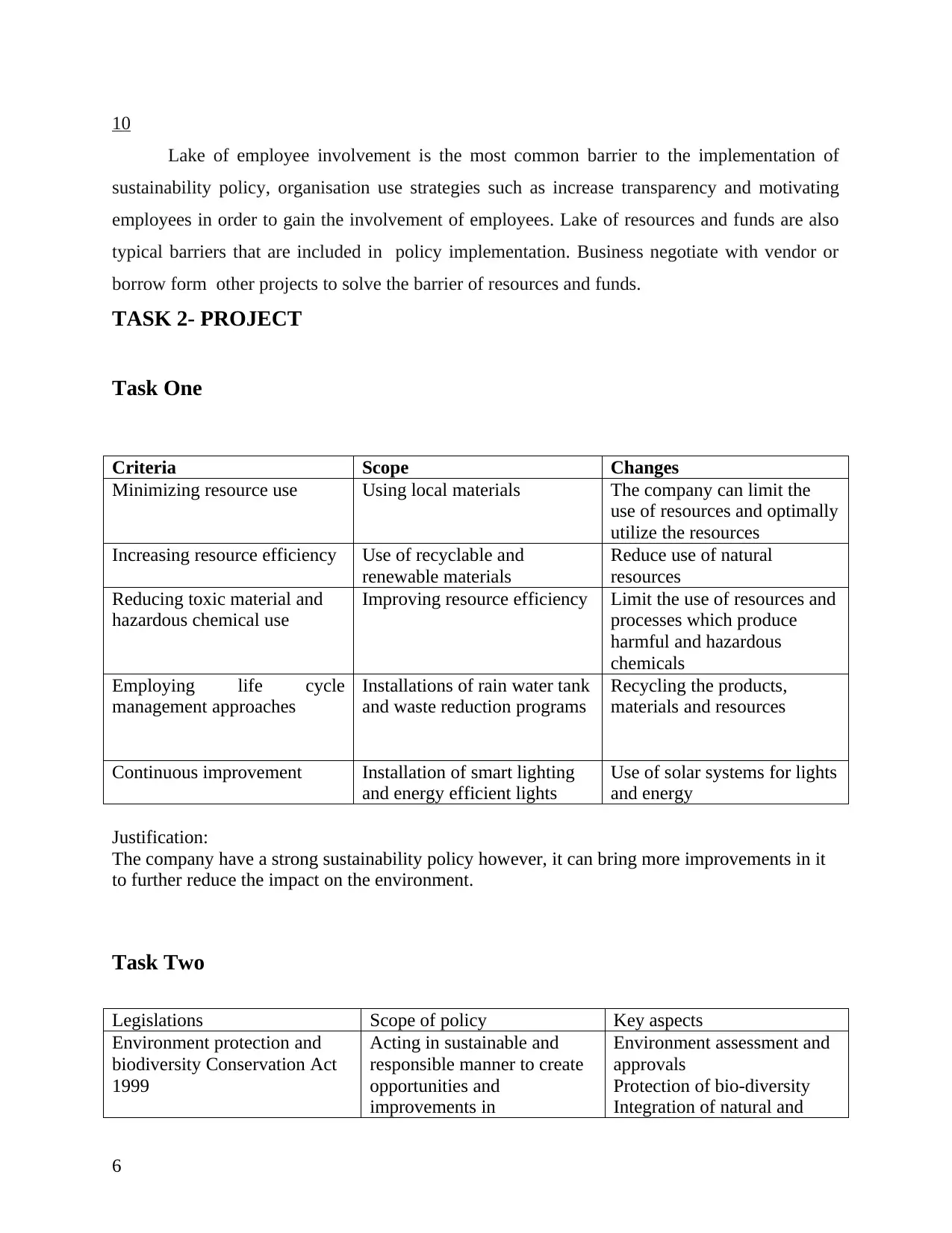
10
Lake of employee involvement is the most common barrier to the implementation of
sustainability policy, organisation use strategies such as increase transparency and motivating
employees in order to gain the involvement of employees. Lake of resources and funds are also
typical barriers that are included in policy implementation. Business negotiate with vendor or
borrow form other projects to solve the barrier of resources and funds.
TASK 2- PROJECT
Task One
Criteria Scope Changes
Minimizing resource use Using local materials The company can limit the
use of resources and optimally
utilize the resources
Increasing resource efficiency Use of recyclable and
renewable materials
Reduce use of natural
resources
Reducing toxic material and
hazardous chemical use
Improving resource efficiency Limit the use of resources and
processes which produce
harmful and hazardous
chemicals
Employing life cycle
management approaches
Installations of rain water tank
and waste reduction programs
Recycling the products,
materials and resources
Continuous improvement Installation of smart lighting
and energy efficient lights
Use of solar systems for lights
and energy
Justification:
The company have a strong sustainability policy however, it can bring more improvements in it
to further reduce the impact on the environment.
Task Two
Legislations Scope of policy Key aspects
Environment protection and
biodiversity Conservation Act
1999
Acting in sustainable and
responsible manner to create
opportunities and
improvements in
Environment assessment and
approvals
Protection of bio-diversity
Integration of natural and
6
Lake of employee involvement is the most common barrier to the implementation of
sustainability policy, organisation use strategies such as increase transparency and motivating
employees in order to gain the involvement of employees. Lake of resources and funds are also
typical barriers that are included in policy implementation. Business negotiate with vendor or
borrow form other projects to solve the barrier of resources and funds.
TASK 2- PROJECT
Task One
Criteria Scope Changes
Minimizing resource use Using local materials The company can limit the
use of resources and optimally
utilize the resources
Increasing resource efficiency Use of recyclable and
renewable materials
Reduce use of natural
resources
Reducing toxic material and
hazardous chemical use
Improving resource efficiency Limit the use of resources and
processes which produce
harmful and hazardous
chemicals
Employing life cycle
management approaches
Installations of rain water tank
and waste reduction programs
Recycling the products,
materials and resources
Continuous improvement Installation of smart lighting
and energy efficient lights
Use of solar systems for lights
and energy
Justification:
The company have a strong sustainability policy however, it can bring more improvements in it
to further reduce the impact on the environment.
Task Two
Legislations Scope of policy Key aspects
Environment protection and
biodiversity Conservation Act
1999
Acting in sustainable and
responsible manner to create
opportunities and
improvements in
Environment assessment and
approvals
Protection of bio-diversity
Integration of natural and
6
⊘ This is a preview!⊘
Do you want full access?
Subscribe today to unlock all pages.

Trusted by 1+ million students worldwide
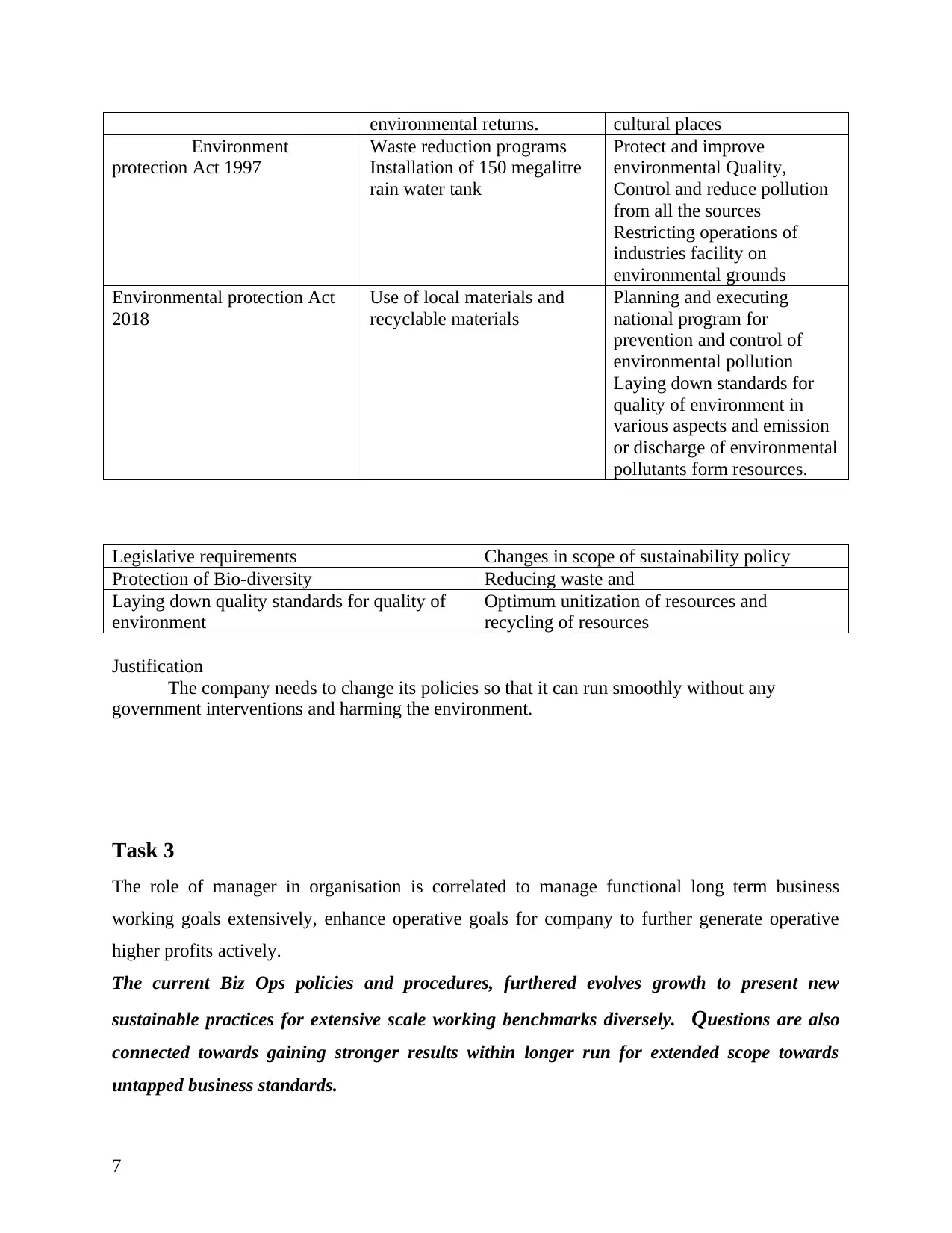
environmental returns. cultural places
Environment
protection Act 1997
Waste reduction programs
Installation of 150 megalitre
rain water tank
Protect and improve
environmental Quality,
Control and reduce pollution
from all the sources
Restricting operations of
industries facility on
environmental grounds
Environmental protection Act
2018
Use of local materials and
recyclable materials
Planning and executing
national program for
prevention and control of
environmental pollution
Laying down standards for
quality of environment in
various aspects and emission
or discharge of environmental
pollutants form resources.
Legislative requirements Changes in scope of sustainability policy
Protection of Bio-diversity Reducing waste and
Laying down quality standards for quality of
environment
Optimum unitization of resources and
recycling of resources
Justification
The company needs to change its policies so that it can run smoothly without any
government interventions and harming the environment.
Task 3
The role of manager in organisation is correlated to manage functional long term business
working goals extensively, enhance operative goals for company to further generate operative
higher profits actively.
The current Biz Ops policies and procedures, furthered evolves growth to present new
sustainable practices for extensive scale working benchmarks diversely. Questions are also
connected towards gaining stronger results within longer run for extended scope towards
untapped business standards.
7
Environment
protection Act 1997
Waste reduction programs
Installation of 150 megalitre
rain water tank
Protect and improve
environmental Quality,
Control and reduce pollution
from all the sources
Restricting operations of
industries facility on
environmental grounds
Environmental protection Act
2018
Use of local materials and
recyclable materials
Planning and executing
national program for
prevention and control of
environmental pollution
Laying down standards for
quality of environment in
various aspects and emission
or discharge of environmental
pollutants form resources.
Legislative requirements Changes in scope of sustainability policy
Protection of Bio-diversity Reducing waste and
Laying down quality standards for quality of
environment
Optimum unitization of resources and
recycling of resources
Justification
The company needs to change its policies so that it can run smoothly without any
government interventions and harming the environment.
Task 3
The role of manager in organisation is correlated to manage functional long term business
working goals extensively, enhance operative goals for company to further generate operative
higher profits actively.
The current Biz Ops policies and procedures, furthered evolves growth to present new
sustainable practices for extensive scale working benchmarks diversely. Questions are also
connected towards gaining stronger results within longer run for extended scope towards
untapped business standards.
7
Paraphrase This Document
Need a fresh take? Get an instant paraphrase of this document with our AI Paraphraser
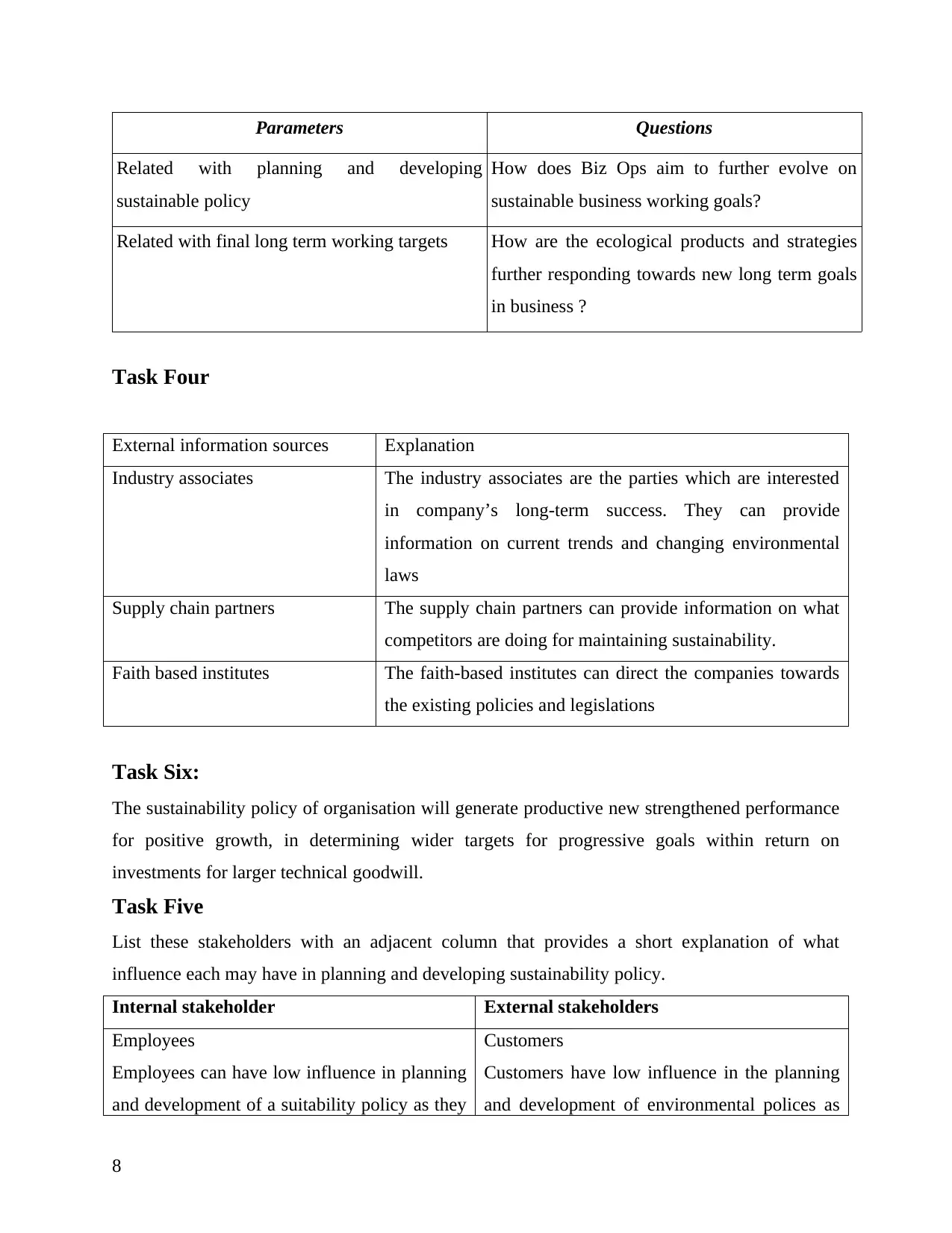
Parameters Questions
Related with planning and developing
sustainable policy
How does Biz Ops aim to further evolve on
sustainable business working goals?
Related with final long term working targets How are the ecological products and strategies
further responding towards new long term goals
in business ?
Task Four
External information sources Explanation
Industry associates The industry associates are the parties which are interested
in company’s long-term success. They can provide
information on current trends and changing environmental
laws
Supply chain partners The supply chain partners can provide information on what
competitors are doing for maintaining sustainability.
Faith based institutes The faith-based institutes can direct the companies towards
the existing policies and legislations
Task Six:
The sustainability policy of organisation will generate productive new strengthened performance
for positive growth, in determining wider targets for progressive goals within return on
investments for larger technical goodwill.
Task Five
List these stakeholders with an adjacent column that provides a short explanation of what
influence each may have in planning and developing sustainability policy.
Internal stakeholder External stakeholders
Employees
Employees can have low influence in planning
and development of a suitability policy as they
Customers
Customers have low influence in the planning
and development of environmental polices as
8
Related with planning and developing
sustainable policy
How does Biz Ops aim to further evolve on
sustainable business working goals?
Related with final long term working targets How are the ecological products and strategies
further responding towards new long term goals
in business ?
Task Four
External information sources Explanation
Industry associates The industry associates are the parties which are interested
in company’s long-term success. They can provide
information on current trends and changing environmental
laws
Supply chain partners The supply chain partners can provide information on what
competitors are doing for maintaining sustainability.
Faith based institutes The faith-based institutes can direct the companies towards
the existing policies and legislations
Task Six:
The sustainability policy of organisation will generate productive new strengthened performance
for positive growth, in determining wider targets for progressive goals within return on
investments for larger technical goodwill.
Task Five
List these stakeholders with an adjacent column that provides a short explanation of what
influence each may have in planning and developing sustainability policy.
Internal stakeholder External stakeholders
Employees
Employees can have low influence in planning
and development of a suitability policy as they
Customers
Customers have low influence in the planning
and development of environmental polices as
8
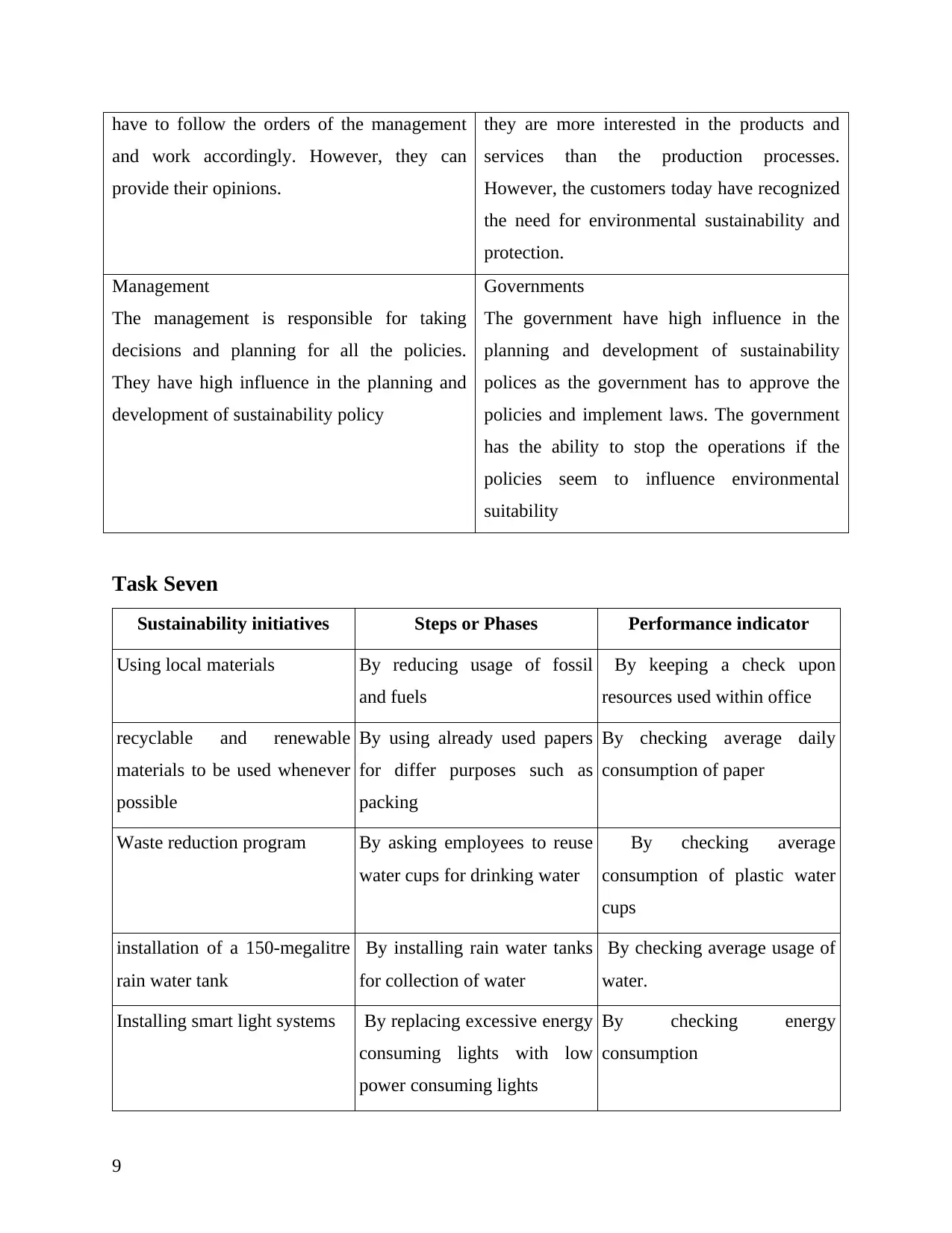
have to follow the orders of the management
and work accordingly. However, they can
provide their opinions.
they are more interested in the products and
services than the production processes.
However, the customers today have recognized
the need for environmental sustainability and
protection.
Management
The management is responsible for taking
decisions and planning for all the policies.
They have high influence in the planning and
development of sustainability policy
Governments
The government have high influence in the
planning and development of sustainability
polices as the government has to approve the
policies and implement laws. The government
has the ability to stop the operations if the
policies seem to influence environmental
suitability
Task Seven
Sustainability initiatives Steps or Phases Performance indicator
Using local materials By reducing usage of fossil
and fuels
By keeping a check upon
resources used within office
recyclable and renewable
materials to be used whenever
possible
By using already used papers
for differ purposes such as
packing
By checking average daily
consumption of paper
Waste reduction program By asking employees to reuse
water cups for drinking water
By checking average
consumption of plastic water
cups
installation of a 150-megalitre
rain water tank
By installing rain water tanks
for collection of water
By checking average usage of
water.
Installing smart light systems By replacing excessive energy
consuming lights with low
power consuming lights
By checking energy
consumption
9
and work accordingly. However, they can
provide their opinions.
they are more interested in the products and
services than the production processes.
However, the customers today have recognized
the need for environmental sustainability and
protection.
Management
The management is responsible for taking
decisions and planning for all the policies.
They have high influence in the planning and
development of sustainability policy
Governments
The government have high influence in the
planning and development of sustainability
polices as the government has to approve the
policies and implement laws. The government
has the ability to stop the operations if the
policies seem to influence environmental
suitability
Task Seven
Sustainability initiatives Steps or Phases Performance indicator
Using local materials By reducing usage of fossil
and fuels
By keeping a check upon
resources used within office
recyclable and renewable
materials to be used whenever
possible
By using already used papers
for differ purposes such as
packing
By checking average daily
consumption of paper
Waste reduction program By asking employees to reuse
water cups for drinking water
By checking average
consumption of plastic water
cups
installation of a 150-megalitre
rain water tank
By installing rain water tanks
for collection of water
By checking average usage of
water.
Installing smart light systems By replacing excessive energy
consuming lights with low
power consuming lights
By checking energy
consumption
9
⊘ This is a preview!⊘
Do you want full access?
Subscribe today to unlock all pages.

Trusted by 1+ million students worldwide
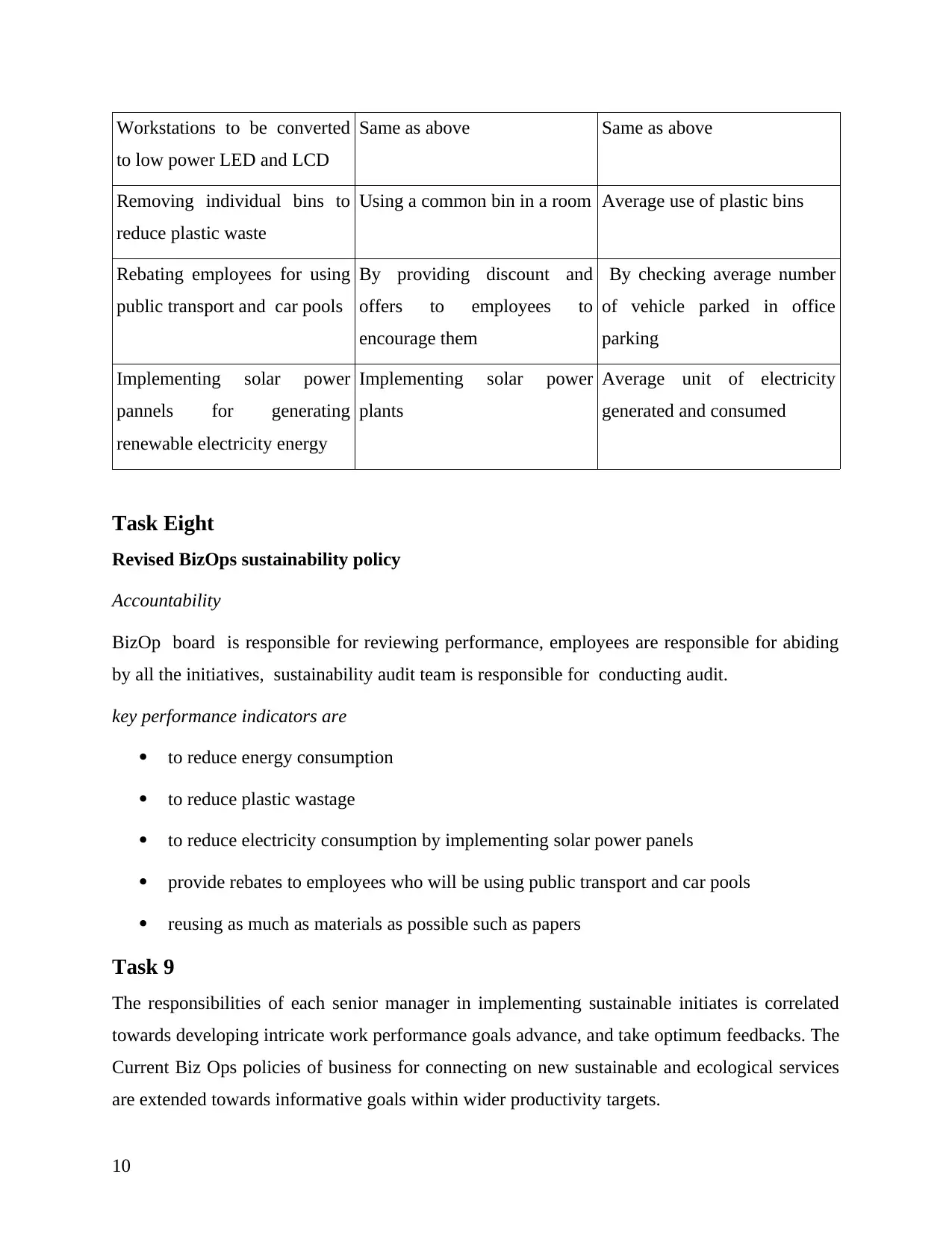
Workstations to be converted
to low power LED and LCD
Same as above Same as above
Removing individual bins to
reduce plastic waste
Using a common bin in a room Average use of plastic bins
Rebating employees for using
public transport and car pools
By providing discount and
offers to employees to
encourage them
By checking average number
of vehicle parked in office
parking
Implementing solar power
pannels for generating
renewable electricity energy
Implementing solar power
plants
Average unit of electricity
generated and consumed
Task Eight
Revised BizOps sustainability policy
Accountability
BizOp board is responsible for reviewing performance, employees are responsible for abiding
by all the initiatives, sustainability audit team is responsible for conducting audit.
key performance indicators are
to reduce energy consumption
to reduce plastic wastage
to reduce electricity consumption by implementing solar power panels
provide rebates to employees who will be using public transport and car pools
reusing as much as materials as possible such as papers
Task 9
The responsibilities of each senior manager in implementing sustainable initiates is correlated
towards developing intricate work performance goals advance, and take optimum feedbacks. The
Current Biz Ops policies of business for connecting on new sustainable and ecological services
are extended towards informative goals within wider productivity targets.
10
to low power LED and LCD
Same as above Same as above
Removing individual bins to
reduce plastic waste
Using a common bin in a room Average use of plastic bins
Rebating employees for using
public transport and car pools
By providing discount and
offers to employees to
encourage them
By checking average number
of vehicle parked in office
parking
Implementing solar power
pannels for generating
renewable electricity energy
Implementing solar power
plants
Average unit of electricity
generated and consumed
Task Eight
Revised BizOps sustainability policy
Accountability
BizOp board is responsible for reviewing performance, employees are responsible for abiding
by all the initiatives, sustainability audit team is responsible for conducting audit.
key performance indicators are
to reduce energy consumption
to reduce plastic wastage
to reduce electricity consumption by implementing solar power panels
provide rebates to employees who will be using public transport and car pools
reusing as much as materials as possible such as papers
Task 9
The responsibilities of each senior manager in implementing sustainable initiates is correlated
towards developing intricate work performance goals advance, and take optimum feedbacks. The
Current Biz Ops policies of business for connecting on new sustainable and ecological services
are extended towards informative goals within wider productivity targets.
10
Paraphrase This Document
Need a fresh take? Get an instant paraphrase of this document with our AI Paraphraser
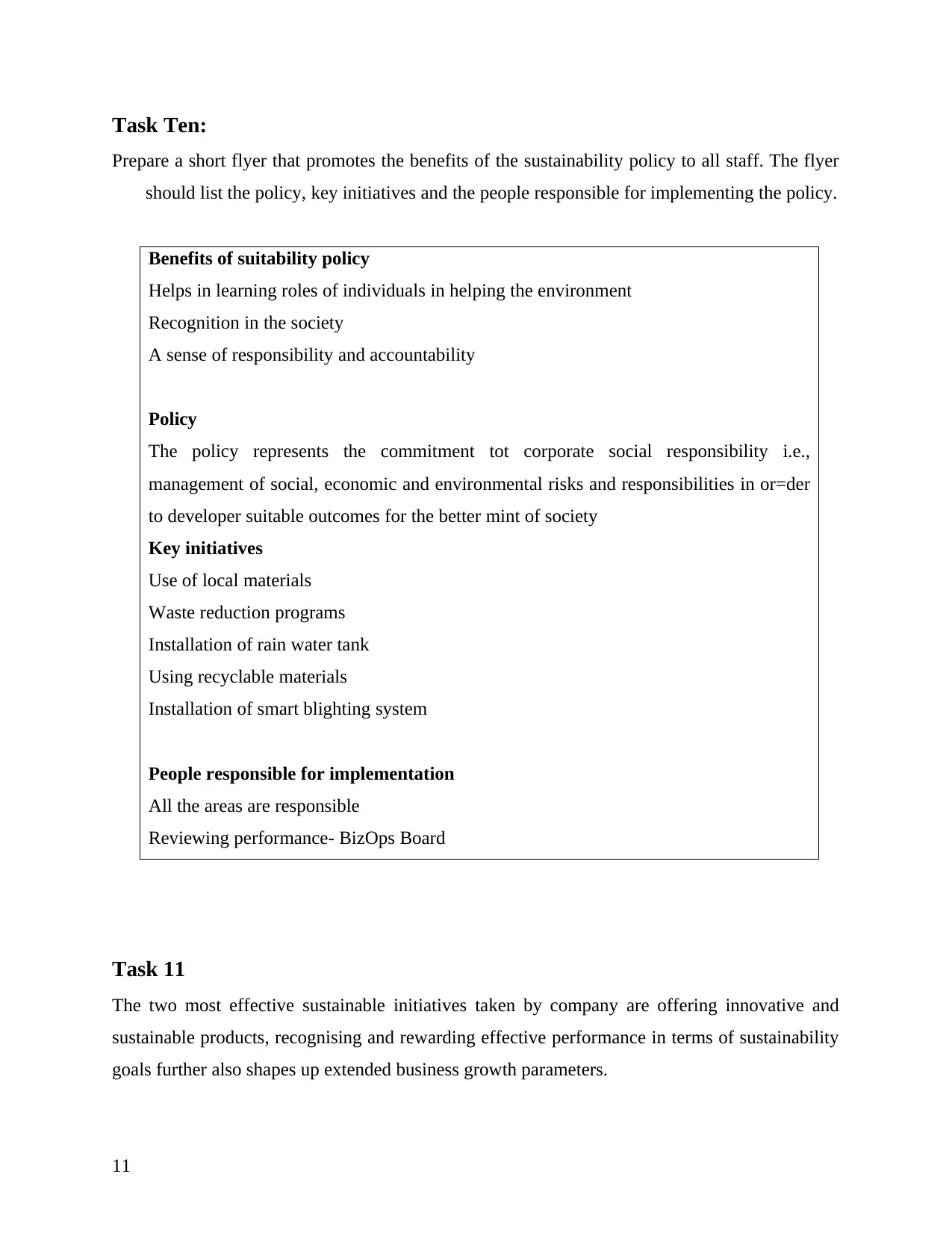
Task Ten:
Prepare a short flyer that promotes the benefits of the sustainability policy to all staff. The flyer
should list the policy, key initiatives and the people responsible for implementing the policy.
Benefits of suitability policy
Helps in learning roles of individuals in helping the environment
Recognition in the society
A sense of responsibility and accountability
Policy
The policy represents the commitment tot corporate social responsibility i.e.,
management of social, economic and environmental risks and responsibilities in or=der
to developer suitable outcomes for the better mint of society
Key initiatives
Use of local materials
Waste reduction programs
Installation of rain water tank
Using recyclable materials
Installation of smart blighting system
People responsible for implementation
All the areas are responsible
Reviewing performance- BizOps Board
Task 11
The two most effective sustainable initiatives taken by company are offering innovative and
sustainable products, recognising and rewarding effective performance in terms of sustainability
goals further also shapes up extended business growth parameters.
11
Prepare a short flyer that promotes the benefits of the sustainability policy to all staff. The flyer
should list the policy, key initiatives and the people responsible for implementing the policy.
Benefits of suitability policy
Helps in learning roles of individuals in helping the environment
Recognition in the society
A sense of responsibility and accountability
Policy
The policy represents the commitment tot corporate social responsibility i.e.,
management of social, economic and environmental risks and responsibilities in or=der
to developer suitable outcomes for the better mint of society
Key initiatives
Use of local materials
Waste reduction programs
Installation of rain water tank
Using recyclable materials
Installation of smart blighting system
People responsible for implementation
All the areas are responsible
Reviewing performance- BizOps Board
Task 11
The two most effective sustainable initiatives taken by company are offering innovative and
sustainable products, recognising and rewarding effective performance in terms of sustainability
goals further also shapes up extended business growth parameters.
11
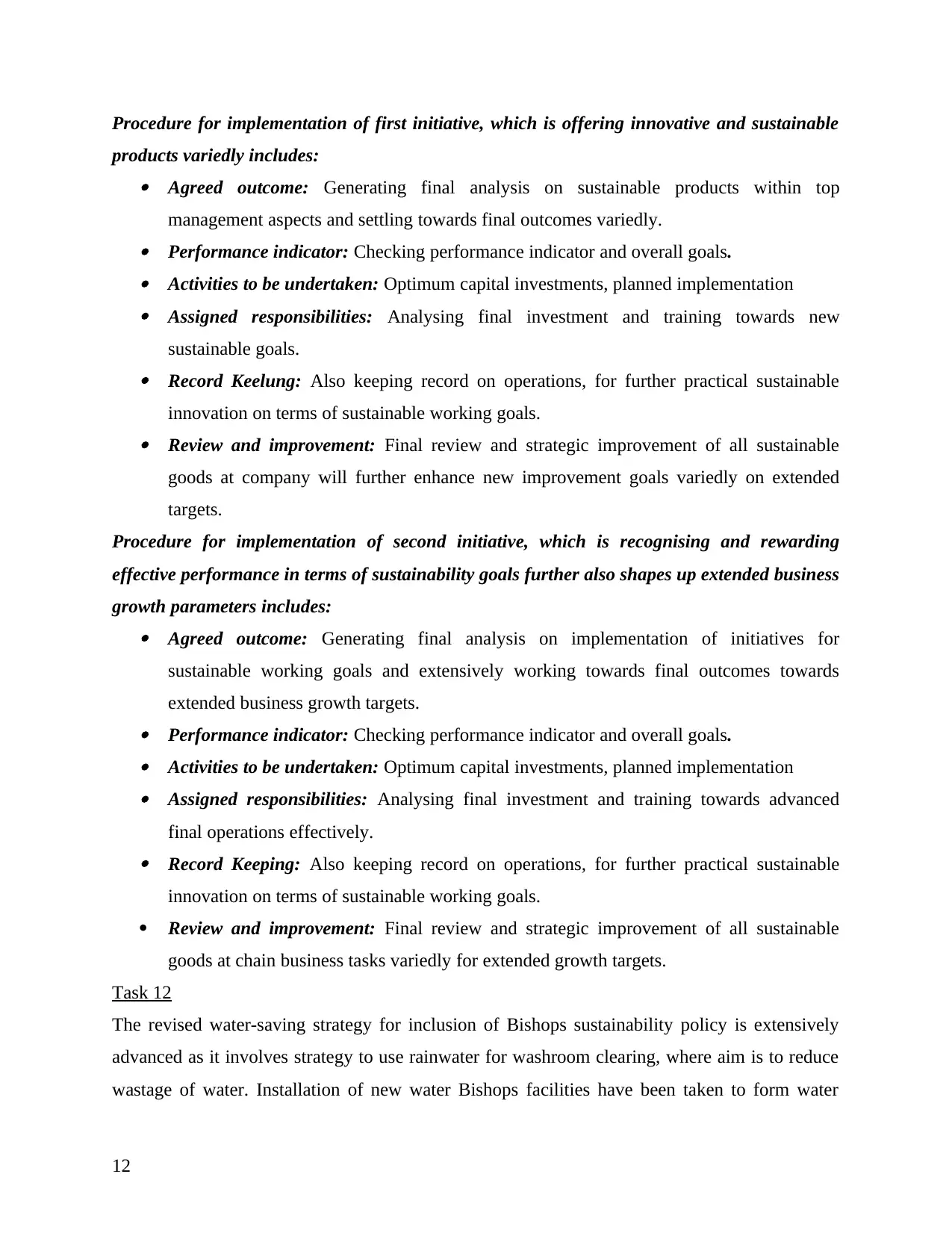
Procedure for implementation of first initiative, which is offering innovative and sustainable
products variedly includes: Agreed outcome: Generating final analysis on sustainable products within top
management aspects and settling towards final outcomes variedly. Performance indicator: Checking performance indicator and overall goals. Activities to be undertaken: Optimum capital investments, planned implementation Assigned responsibilities: Analysing final investment and training towards new
sustainable goals. Record Keelung: Also keeping record on operations, for further practical sustainable
innovation on terms of sustainable working goals. Review and improvement: Final review and strategic improvement of all sustainable
goods at company will further enhance new improvement goals variedly on extended
targets.
Procedure for implementation of second initiative, which is recognising and rewarding
effective performance in terms of sustainability goals further also shapes up extended business
growth parameters includes: Agreed outcome: Generating final analysis on implementation of initiatives for
sustainable working goals and extensively working towards final outcomes towards
extended business growth targets. Performance indicator: Checking performance indicator and overall goals. Activities to be undertaken: Optimum capital investments, planned implementation Assigned responsibilities: Analysing final investment and training towards advanced
final operations effectively. Record Keeping: Also keeping record on operations, for further practical sustainable
innovation on terms of sustainable working goals.
Review and improvement: Final review and strategic improvement of all sustainable
goods at chain business tasks variedly for extended growth targets.
Task 12
The revised water-saving strategy for inclusion of Bishops sustainability policy is extensively
advanced as it involves strategy to use rainwater for washroom clearing, where aim is to reduce
wastage of water. Installation of new water Bishops facilities have been taken to form water
12
products variedly includes: Agreed outcome: Generating final analysis on sustainable products within top
management aspects and settling towards final outcomes variedly. Performance indicator: Checking performance indicator and overall goals. Activities to be undertaken: Optimum capital investments, planned implementation Assigned responsibilities: Analysing final investment and training towards new
sustainable goals. Record Keelung: Also keeping record on operations, for further practical sustainable
innovation on terms of sustainable working goals. Review and improvement: Final review and strategic improvement of all sustainable
goods at company will further enhance new improvement goals variedly on extended
targets.
Procedure for implementation of second initiative, which is recognising and rewarding
effective performance in terms of sustainability goals further also shapes up extended business
growth parameters includes: Agreed outcome: Generating final analysis on implementation of initiatives for
sustainable working goals and extensively working towards final outcomes towards
extended business growth targets. Performance indicator: Checking performance indicator and overall goals. Activities to be undertaken: Optimum capital investments, planned implementation Assigned responsibilities: Analysing final investment and training towards advanced
final operations effectively. Record Keeping: Also keeping record on operations, for further practical sustainable
innovation on terms of sustainable working goals.
Review and improvement: Final review and strategic improvement of all sustainable
goods at chain business tasks variedly for extended growth targets.
Task 12
The revised water-saving strategy for inclusion of Bishops sustainability policy is extensively
advanced as it involves strategy to use rainwater for washroom clearing, where aim is to reduce
wastage of water. Installation of new water Bishops facilities have been taken to form water
12
⊘ This is a preview!⊘
Do you want full access?
Subscribe today to unlock all pages.

Trusted by 1+ million students worldwide
1 out of 15
Related Documents
Your All-in-One AI-Powered Toolkit for Academic Success.
+13062052269
info@desklib.com
Available 24*7 on WhatsApp / Email
![[object Object]](/_next/static/media/star-bottom.7253800d.svg)
Unlock your academic potential
Copyright © 2020–2025 A2Z Services. All Rights Reserved. Developed and managed by ZUCOL.





